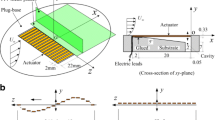Abstract
An artificially synthesized velocity field with known properties is used as a test data set in analyzing and interpreting the turbulent flow velocity fields. The objective nature of this approach is utilized for studying the relation between streaky and eddy structures. An analysis shows that this relation may be less significant than is customarily supposed.
Similar content being viewed by others
References
A.V. Boiko, G.R. Grek, A.V. Dovgal’, and V.V. Kozlov, Development of Turbulence in Near-Wall Flows [in Russian], Nauka, Novosibirsk (1999).
S. I. Chernyshenko and M. F. Baig, “The mechanism of streak formation in near-wall turbulence,” J. Fluid Mech., 44, 99–131 (2005).
R. J. Adrian, K. T. Christensen, and Z.-C. Liu, “Analysis and interpretation of instantaneous turbulent velocity fields,” Experim. Fluids, 29, No. 3, 275–290 (2000).
M. S. Chong, A. E. Perry, and B. J. Cantwell, “A general classification of three-dimensional flow field,” Phys. Fluids A, 2, No. 5, 765–777 (1990).
I. Marusic, “On the role of large-scale structures in wall turbulence,” Phys. Fluids, 13, No. 5, 735–743 (2001).
A. Smirnov, S. Shi, and I. Celik, “Random flow generation technique for large eddy simulations and particle-dynamics modeling,” Trans. ASME. J. Fluids. Engng., 123, No. 2, 359–371 (2001).
D. R. Osborne, J. C. Vassilicos, and J. D. Haigh, “One particle two-time diffusion in three-dimensional homogeneous isotropic turbulence,” Phys. Fluids, 1y, No. 3, 03510.1–035104.11 (2005).
G. Kawahara, J. Jiménez, M. Uhlmann, and A. Pinelli, “The instability of streaks in near-wall turbulence,” Annu. Res. Briefs, CTR, 155–170 (1998).
Z. Hu, Chr. J. Morfey, and N. D. Sandham, “Sound radiation in turbulent channel flows,” J. Fluid Mech., 475, 269–302 (2003).
C.D. Tomkins and R. J. Adrian, “Spanwise structure and scale growth in turbulent boundary layers, ” J. Fluid Mech., 490, 37–74 (2003).
P. R. Spalart, “Direct simulation of a turbulent boundary layer up to Re = 1410,” J. Fluid Mech., 187, 61–98 (1988).
S. Robinson, “Coherent motions in the turbulent boundary layer,” Annu. Rev. Fluid Mech., 23, 601–639 (1991).
G. Berkooz, P. J. Holmes, and J. L. Limley, “The proper orthogonal decomposition in the analysis of turbulent flows,” Annu. Rev. Fluid Mech., 25, 539–575 (1993).
Z. Hu and N. D. Sandham, “DNS databases for turbulent Couette and Poiseuille flow,” Technical Report 01/04. 2002, AFM Research Group, SES, Univ. Southampton (2001).
M.-G. Di Cicca, G. Iuso, P.G. Spazzini, and M. Onorato, “Particle image velocimetry investigation of turbulent boundary layer manipulated by spanwise wall oscillations,” J. Fluid Mech., 467, 41–56 (2002).
Additional information
__________
Translated from Izvestiya Rossiiskoi Academii Nauk, Mekhanika Zhidkosti i Gaza, No. 5, 2006, pp. 108–121.
Original Russian Text Copyright © 2006 by Chernyshenko, Di Cicca, Iollo, Smirnov, Sandham, and Hu.
Rights and permissions
About this article
Cite this article
Chernyshenko, S.I., Di Cicca, G., Iollo, A. et al. Analysis of data on the relation between eddies and streaky structures in turbulent flows using the placebo method. Fluid Dyn 41, 772–783 (2006). https://doi.org/10.1007/s10697-006-0094-z
Received:
Issue Date:
DOI: https://doi.org/10.1007/s10697-006-0094-z




